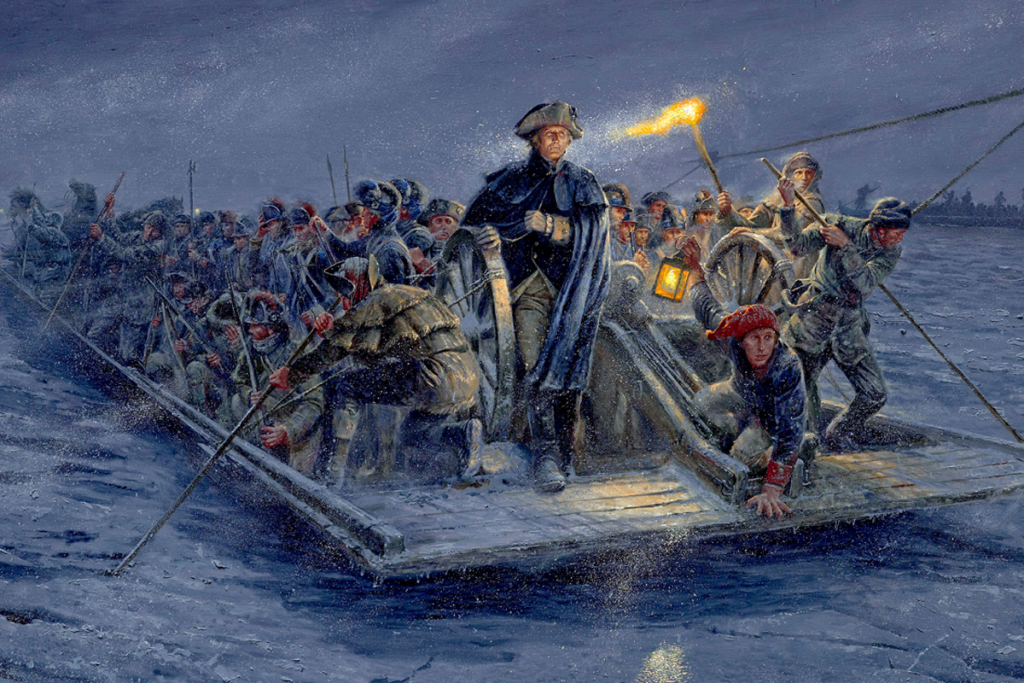By the end of December 1776, things looked bleak for George Washington and his Continental Army. After suffering a series of crushing defeats, his forces had been pushed out of New Jersey and were now huddled along the western banks of the Delaware River in Pennsylvania. On the other side, the British, under the command of General William Howe, had taken up winter quarters, convinced that the war was as good as won.

But Washington had other plans. He knew that unless he achieved a decisive victory soon, the Revolution might be over. On the night of December 25, 1776, he decided to launch a surprise attack on the Hessian garrison in Trenton.
Why Trenton?
Trenton, located just across the Delaware River, was an ideal target. First, it was within reach—his army could cross the river and march there before dawn. Second, it was guarded by Hessian mercenaries, German soldiers hired by the British. Unlike the British, these men had no ties to the American colonies, making them a hated enemy. And third, it was the day after Christmas—Washington gambled that the Hessians would be in no shape to fight after a night of holiday revelry.
Who Were the Hessians?
The Hessians, formally known as German mercenaries, were among the most feared soldiers in the war. Hailing from the many small states of Germany, particularly Hesse-Kassel, they were professional warriors who fought for whoever paid them the most. The British employed about 30,000 of them during the American Revolution. Their reputation was brutal—they were known for their discipline, ruthlessness, and efficiency in battle. But their presence in America caused resentment, even among British sympathizers. Many saw it as a betrayal that the British crown would use foreign troops to fight its own colonial subjects. Ironically, thousands of Hessians would later desert and settle in America, finding the New World much more appealing than the battlefields of Europe.
The Legendary Crossing
On the frigid night of December 25, Washington and 2,400 troops began their dangerous crossing of the icy Delaware River. The operation was led by Colonel John Glover and his regiment of Massachusetts fishermen, experts in navigating treacherous waters. It was slow and perilous—floating ice, strong winds, and a snowstorm made the journey almost impossible. The famous painting Washington Crossing the Delaware captures this moment, though it takes some artistic liberties (Washington likely did not dramatically stand in the boat, risking an unceremonious dunk into the icy waters).
Due to the storm, the crossing took much longer than expected. By the time the last soldier reached the New Jersey shore, it was 3 AM—several hours behind schedule. This meant they would not reach Trenton before sunrise. The element of total surprise was slipping away. Yet Washington was determined. As he famously said, “Victory or death.”
The Battle of Trenton
At 8 AM on December 26, the exhausted but determined Continental Army reached Trenton. Despite fears that their presence had been detected, the Hessians were caught off guard. Their commander, Colonel Johann Rall, had received intelligence about a possible attack but dismissed it. The previous night’s Christmas festivities had left many of his men groggy and unprepared.
With most of their gunpowder soaked from the storm, Washington’s men fought with bayonets, overwhelming the Hessians in brutal close combat. In less than an hour, the battle was over. The Americans captured nearly 900 Hessians, a massive victory that revitalized the morale of the Continental Army.
The Impact: A War Turned on Its Head
The victory at Trenton did more than just defeat a Hessian regiment. It proved that Washington’s army was still a force to be reckoned with. The news spread quickly, and soldiers who had been ready to desert now reenlisted with newfound confidence. Just a week later, Washington struck again at Princeton, securing another critical victory. These battles helped shift momentum in the war and kept the Revolution alive.
The boldness of Washington’s decision—to attack in the dead of winter, against all odds—demonstrated the kind of leadership that would eventually lead America to victory. Today, the crossing of the Delaware is remembered as one of the most iconic moments in American history, symbolizing determination, courage, and the willingness to take risks when everything is on the line.
Legacy and Modern Connections
The story of Washington’s crossing continues to inspire military strategy and leadership discussions today. It highlights the importance of seizing the initiative, thinking outside conventional rules of engagement, and persevering through adversity. The event is commemorated every year in Washington Crossing, Pennsylvania, where reenactors brave the icy waters to relive that daring night.
In the grand arc of history, Trenton was not the largest battle, but it was a turning point. Washington didn’t just win a fight—he reignited the flame of the Revolution. And as the Hessians discovered, sometimes the worst hangover isn’t from too much beer—it’s from underestimating your enemy.

No comments yet.